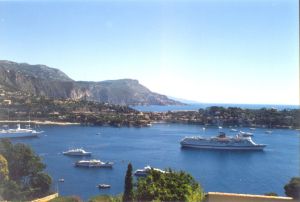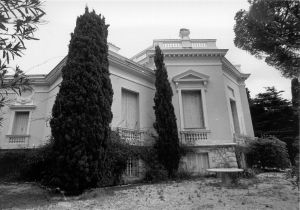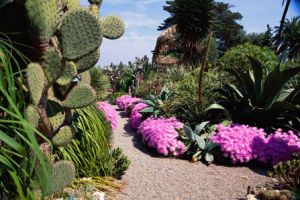History on St Jean Cap Ferrat
Article on St Jean Cap Ferrat by the journalist Raoul Mille "Nice Matin", Sunday February 25th, 2001.
"At the end of the 19th century Cap Ferrat consisted of wild, uncultivated countryside used for fox hunting. In the summer months shepherds from the high country brought their flocks there to graze amongst the olive trees. There were no roads, only a few paths and isolated dwellings.

This paradise was discovered by Leopold II, King of Belgium, who fell in love with the area at first sight. He was a robust old man with a fine beard and side whiskers who had devoted his life to accumulating land and territories for himself and his country. It was he who appropriated the Congo and made it part of the Belgian empire. He was not so much a conqueror as a very astute businessman, who ran his country much as he would a factory.
In 1895 the King came to the Riviera for a visit, and stayed in the Grand Hotel of Cimiez (Nice) with his daughter Clementine. One fine winter's day on a trip to Beaulieu, he discovered the beauties of the Bay of Passable and St Hospice, caressed by the gentle waves of the Mediterranean.
Near Passable he discovered a modest building, the villa "Vial", and immediately declared that he would buy the property, which he did. He proceeded to acquire around 15 plots of land in the surrounding area, whose owner's were amazed to find somebody so anxious to buy these "useless" bits of land.
The King decided to build a palace there ("The Leopolda") the plans of which were drawn up by the Niçois architect Aron Messiah. Did the astute King Leopold realize the future value of the land or was he just a prey to his insatiable acquisitiveness...? He may have had a more "human" motive in the form of a young lady called Blanche Delacroix.
When Leopold first met her she was sixteen years old and he was sixty five. The King had never loved his wife, Queen Marie- Henriette, chosen for him by his father Leopold I. A strong sense of filial duty led him to father four children by her, after which she was largely ignored, and Leopold contented himself with various love affairs.
However, the king could not resist Blanche's fresh blond beauty, and soon she accompanied him wherever he went. Naturally the proprieties were respected: they never spoke to each other in public, they stayed at the same hotels but did not share a room, and dined at the same time but at separate tables.

Cap Ferrat was the ideal spot for an illicit love affair, well hidden from prying eyes. The King set Blanche up at the ex villa Vial at Passable, renamed the "Radiana". A golden prison with panoramic sea views, lost in the midst of luxuriant vegetation. Blanche spent her days there alone waiting for her royal lover who forbade her to go out or to receive other visitors. In order to be near Blanche the King, who already owned a sizeable portion of the Cap, bought a nearby house owned by Desiré Pollonnais, former Mayor of Villefranche, who used to grow fruit trees and even vines there. The King transformed this bucolic paradise into a superb property called "Les Cèdres".

Les Cèdres was only a step away from Blanche's villa and every evening the King, equipped with a dim lantern, would make his way to the villa following a little path hidden by the trees. He spent two hours with Blanche, officially playing cards, but nevertheless found the time to father two children, Lucien and Philippe who both had "Father unknown" written on their birth certificates. The gardener at the "Léopolda" had orders to deliver a basket of fresh flowers every day to the recluse of the Villa Radiana.
However, while Leopold was living out his idyll of love, critical voices were being raised about his harsh treatment of his daughters. Where they were concerned the King was a pillar of moral rectitude. His daughter Louise committed adultery with a Croatian officer in Vienna and sought a divorce from her husband Phillip of Saxe Coburg & Gotha in order to be able to remarry. Leopold had her interned along with her lover. Later on, after their release, the lovers fled to Paris.
Another of his daughters, Stéphanie, wished to put an end to her widowhood after ten long years of mourning, the King refused and stopped her allowance. As for Clémentine who wanted to marry a descendent of Napoleon, Leopold bought her a villa in St Raphael and told her to stay put and devote herself to good works among the local poor.
These double standards exasperated the Belgian aristocracy who were further annoyed when the King bestowed the title "Baroness of Vaughan" on Blanche, the daughter of a humble civil servant. Leopold's frequent absences were much criticized in Brussels.
A socialist deputy declared that "Leopold II was not only King of Nice but also King of Belgium, and that his role was not solely to preside over the Nice Carnival, but also to attend cabinet meetings". Leopold was unmoved by such criticisms, and continued to buy up all the land for sale on Cap Ferrat.
Between 1904 and 1905 he built no less than three villas near the lighthouse. Most of the time, Leopold did not even occupy the villas, as he preferred staying on his yacht in the Bay of Villefranche.
The King's insatiable appetite for land was beginning to worry local people and Georges Maurevert, a journalist with the "Eclaireur de Nice", wrote that "at this rate the whole of Cap Ferrat will soon belong to King Leopold and there will be nothing more to do except put up a sign at the entrance saying "Belgian colony - Keep Out". The King was not only a business man, he also had a genuine love of St Jean Cap Ferrat which he tried to mould to his own taste by introducing exotic plants and trees at the expense of local vegetation.
This superb variety of botanical species can still be admired today.
Leopold once remarked to a friend :"I consider the beautiful lands of the Alpes Maritimes and Var region, together with the Principality of Monaco to be earthly sections of Paradise". Leopold was a curious man who always spoke of himself in the third person. Other eccentricities included regularly having buckets of sea water thrown over him to tone his muscles and having his daily paper carefully ironed before he sat down to read it. It is said he wrapped his beard in a cloth before making his nocturnal visits to Blanche so that she would not be made uncomfortable by contact with a beard moist from the damp night air.
Leopold died in 1909 in his palace at Laeken with Blanche at his side, and it is rumoured that a religious marriage ceremony took place. Upon his death the Baroness of Vaughan kept a very low profile. She was a frequent visitor at the hotel "La Réserve" at Beaulieu, but avoided St Jean Cap Ferrat and the Villa Radiana.., no doubt because of all the memories it held."
Relative article on Cap Ferrat and Villefranche:
Alexandra Lloyd Properties © 2025 - All rights reserved - Legal notice
French Riviera | France villa rental